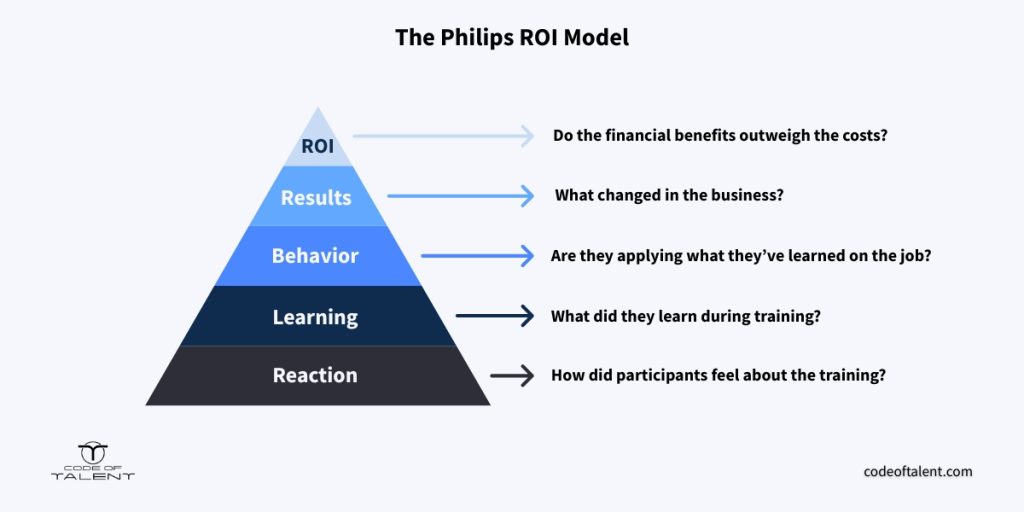There’s always a time in an L&D team’s end-of-year report where someone asks about training ROI (or return on investment). This is the number that shows whether the investment in learning made a difference, the sole proof to company executives that training matters for their companies.
For example, according to Accenture, companies earn $4.53 for every dollar spent on training. That’s a 353% ROI and a clear signal that well-designed learning programs can drive serious business value.

So how do you measure it and improve it? This article breaks it all down.
Why Measure Your Training ROI
Knowing the return on training helps L&D teams make smarter decisions. Here’s what measuring training ROI can unlock:
Aligning Training with Business Goals
Executives speak in numbers, and ROI is one of the most important L&D KPIs. Measuring training ROI helps ensure learning programs support the outcomes that matter most to the business, like:
- Performance
- Productivity
- Customer satisfaction.
Justifying Budget to Stakeholders
Without data, training is often seen as a cost. ROI gives learning teams the evidence they need to secure buy-in and funding.
Simply put, proving efficiency leads to more budget, which means more training. And more training drives business impact. For example, according to Deloitte, companies with strong learning cultures have employee engagement and retention rates 30–50% higher than their peers.
Driving Continuous Improvement
Tracking ROI helps L&D teams see what’s working and where to improve. For employees, training initiatives are an important factor for their commitment and engagement in the workplace. SHRM reports that 76% of employees are more likely to stay with a company that offers continuous training.
So, measuring training ROI supports both employee growth and program improvement.
The Training ROI Formula: How to Calculate It Accurately
Understanding training ROI starts with defining the inputs and knowing the limits of the numbers you’re working with.
1. Definitions: Benefits vs Costs
At its core, training ROI compares what you spend with what you get in return.
Costs are what you pay for: the design of the program, the tools and platforms used, trainers or facilitators, content development, and the time employees spend in training instead of doing their regular work.
Benefits are what you gain: improvements in skills, knowledge, behavior, or business outcomes. To calculate ROI, these benefits need to be translated into financial terms, like increased revenue, reduced costs, or fewer mistakes.
A Practical Example: Training Sales Teams in Customer Service
Let’s say you’re training a sales team to improve how they handle customer interactions.
Costs might include:
Category | Estimated cost |
|---|---|
External trainer fee | $5,000 |
Learning platform license | $2,000 |
Employee time (10 reps × 4 hours × $30/hour) | $1,200 |
Manager time for follow-up coaching | $800 |
Support materials and setup | $500 |
Total | $9,500 |
Benefits could include:
Category | Estimated gain |
Increase in repeat customers | Estimated added revenue of $12,000 over 3 months |
Higher average order value | $5,000 |
Fewer refunds or escalations | $1,500 |
Total | $18,500 |
Disclaimer: These numbers are fictional and used only for illustrative purposes. Actual training costs and benefits can vary widely depending on your industry, company size, and specific training goals.
ROI tells you whether the value of those improvements outweighs what you spent. If the sales team closes more deals or improves review scores after training, you have measurable results to attribute.
When those results are worth more than the total cost, you’ve achieved a positive ROI. A negative ROI shows a loss or a need to rethink your strategy.
2. The Basic Formula
ROI (%) = (Benefits – Costs) ÷ Costs × 100

From our example:
- Benefits = $18,500
- Costs = $9,500
ROI (%) = ($18,500 – $9,500) ÷ $9,500 × 100
ROI (%) = $9,000 ÷ $9,500 × 100
ROI (%) ≈ 94.7%
So in this case, the training generated a 94.7% return on the investment, nearly double the cost. That’s a strong indicator the program was worth it.
Going Deeper with the Phillips ROI Model
The basic ROI formula is a good starting point, but it has limits, especially when you’re trying to link training to real business outcomes. That’s where the Phillips ROI Model comes in.
Developed by Jack Phillips, this model expands on the well-known Kirkpatrick Four Levels of Evaluation, which measure how learners react to training, what they learned, whether they applied it, and what results followed. Phillips adds a fifth level (ROI) which asks a deeper question: was the training worth the investment financially?
Here’s how the five levels break down:
- Reaction – How did participants feel about the training? Was it engaging and relevant?
- Learning – What knowledge or skills did they gain?
- Behavior – Are they applying those skills on the job?
- Results – What changed in the business (e.g. fewer errors, better service, higher sales)?
- ROI – Do the financial benefits outweigh the costs?

Whereas traditional evaluation stops at “Did they learn it?”, the Phillips model pushes further: “Did the learning drive real business results, and were those results worth what we spent?”
What makes this model powerful is its focus on isolating the effects of training—so you’re not crediting the program for changes that were caused by something else—and converting those results into financial terms. That gives leaders data they can actually act on.
The model is widely used by Fortune 500 companies, public-sector agencies, and global L&D teams that need to evaluate programs where the financial return needs to be clear, not assumed.
Common Challenges in Estimating ROI
Even with a clear formula, calculating ROI isn’t always straightforward.
- It’s hard to isolate training from other performance drivers
- Not every outcome is easy to assign a dollar value
- Deep ROI analysis takes time, data, and sometimes external support
Still, even a rough estimate is better than none.
7 Ways to Maximize Training ROI and Get the Best Results
Training ROI isn’t just something you measure after the fact. It’s something you can design for from the start. Here are seven ways to boost the return on your learning programs:
1. Target Training to High-Impact Areas
Focus your efforts where training will create the most value (like onboarding, leadership development, customer service, or compliance). These areas often have clear business outcomes tied to performance, making it easier to track ROI.
2. Use Blended Delivery
Blended delivery improves ROI because it increases learner engagement, shortens time to productivity, and gives employees more opportunities to apply what they’ve learned faster. Common formats include:
- Instructor-led training (ILT): Provides direct interaction with experts and allows real-time Q&A, improving comprehension and motivation.
- E-learning modules: Flexible and scalable, reducing travel and scheduling costs while allowing learners to go at their own pace.
- Microlearning: Short, focused bursts of content that improve retention and fit into busy schedules, reducing time away from work.
- On-the-job experience: Hands-on practice in real work settings that reinforces learning immediately. In fact, a study by Ipsos found that 66% of workers prefer on-the-job learning over traditional formal courses, highlighting the value of practical application.
- Workshops or peer coaching: Encourage collaboration, feedback, and shared learning, which deepen understanding.
3. Set and Track Realistic Training KPIs
Establish clear, measurable training KPIs such as completion rates, assessment scores, learner engagement, and time to productivity. Tracking these alongside business metrics like productivity or error rates provides a full picture of training effectiveness.
Leveraging training data analytics tools makes monitoring easier and helps improve ROI.
4. Use Manager Involvement and Follow-up
Managers reinforce learning, track behavior changes, and link new skills to goals, which improves skill application and productivity. Manager involvement also develops leadership skills as managers mentor others and deepen their own understanding by teaching. This creates a culture of continuous learning and accountability.
From an ROI perspective, engaged managers help turn training into real business results instead of wasted effort.
5. Focus on Reducing Turnover and Operational Errors
High employee turnover and absenteeism create significant costs, from recruiting and onboarding new hires to lost productivity and overtime. Effective training helps employees feel more competent, which boosts retention and reduces absenteeism.
Similarly, training that targets operational errors (like mistakes in customer service, compliance, or manufacturing) can lower costly errors.
These savings increase training’s financial benefits, improving ROI.
6. Reinforce Learning with Real-World Practice
Training works best when learners apply skills quickly. Using simulations, role-play, peer reviews, or live feedback helps make learning stick and translates into better on-the-job performance.
This faster skill application speeds up results and reduces skill decay, increasing the benefits gained from your training investment and improving ROI.
7. Analyze ROI Data and Iterate
Tracking training results over time lets you see what’s working and what isn’t. By comparing different learner groups or program versions, you can identify strengths and weaknesses.
In short, regularly analyzing ROI helps you optimize your programs for maximum business impact and ensures each dollar invested delivers better results than the last.
How to Use Code of Talent to Maximize Training ROI
Code of Talent is an all-in-one learning platform designed to deliver engaging, personalized, and scalable training that drives real business results.
The platform offers a range of features designed to boost training ROI by making learning engaging and easy to manage:
- Microlearning: Breaks training into short, focused lessons that fit easily into busy workdays. This helps learners retain information better, leading to quicker skill application and improved performance.
- Gamification: Uses elements like leaderboards, badges, and rewards to make learning fun and competitive. This helps with motivation and participation.
- Flexible deployment: Training can be accessed via QR code scanning, email invitations, uploading learner databases, direct links, or direct platform invitations, making it easy to roll out at scale.
- AI-generated missions: AI quickly reads large amounts of training material and converts it into missions for teams or departments within minutes, cutting content development costs and saving time.
- AI virtual assistant: Provides instant feedback on learner responses, freeing trainers from repetitive tasks and keeping engagement high.
- Mobile-friendly design: Learners can access training anytime, anywhere on any device, which increases participation and allows employees to learn at their own pace.
- Multi-language support: The platform supports multiple languages, helping global teams overcome language barriers.
- Training data analysis: Robust analytics track learner progress, engagement, and performance metrics so you can make informed decisions to improve future training and maximize ROI.

Case Study: Onboarding for Hospitality
Let’s say you need to onboard a team of five servers at your restaurant. Using Code of Talent, you can:
- Deliver standardized training quickly without scheduling multiple sessions
- Use microlearning and gamification to keep new hires engaged and reduce time to competency
- Track progress in real time, allowing managers to focus on coaching rather than admin tasks
- Reduce printing, travel, and instructor costs
Compared to traditional onboarding, these savings can add up quickly, improving your training ROI by lowering costs and speeding up new hire readiness.
Ready to see how Code of Talent can improve your training ROI? Start your free trial today and experience the benefits firsthand.
Cover photo: Freepik





